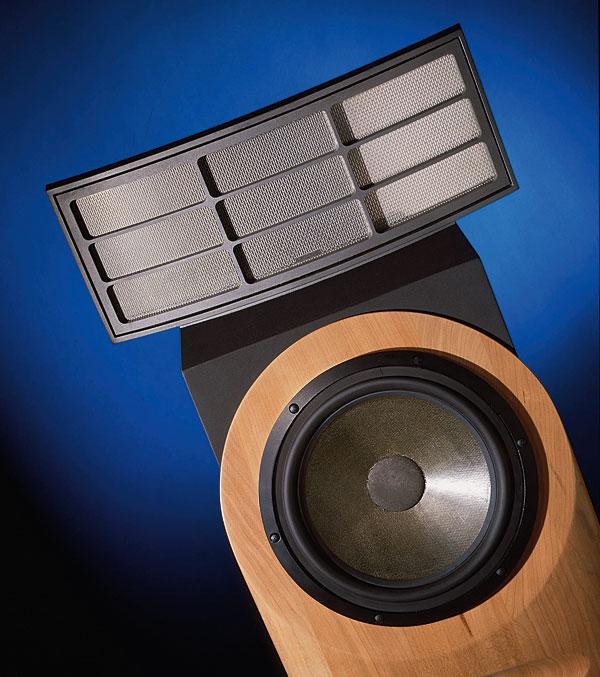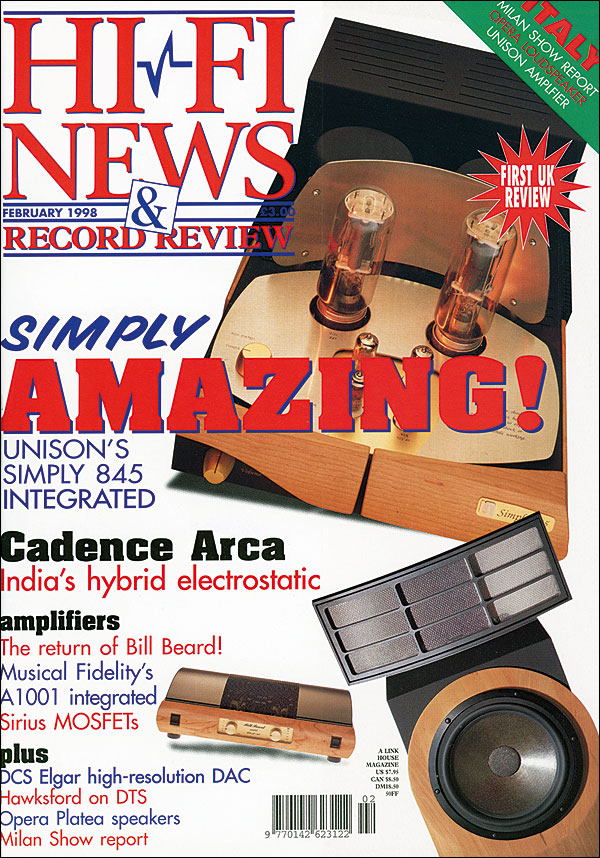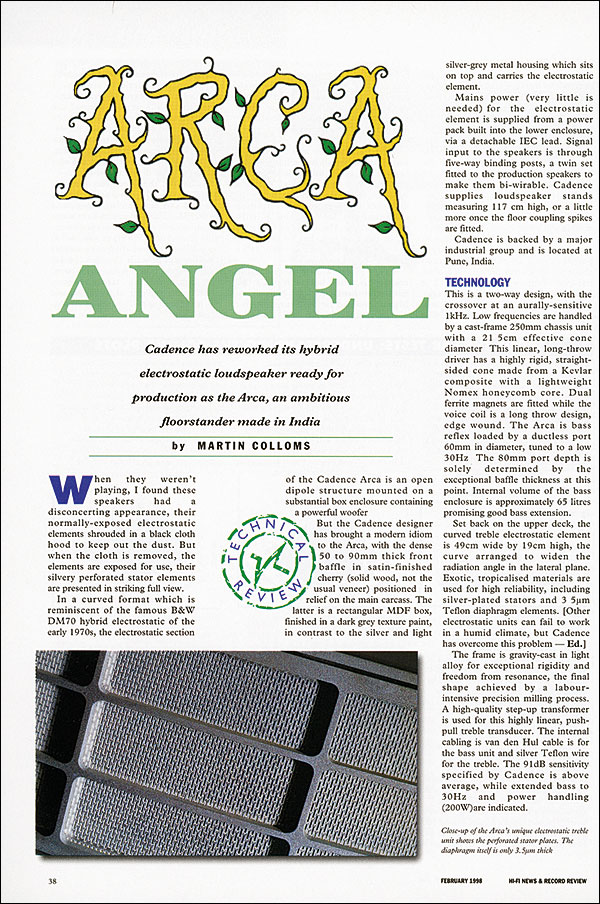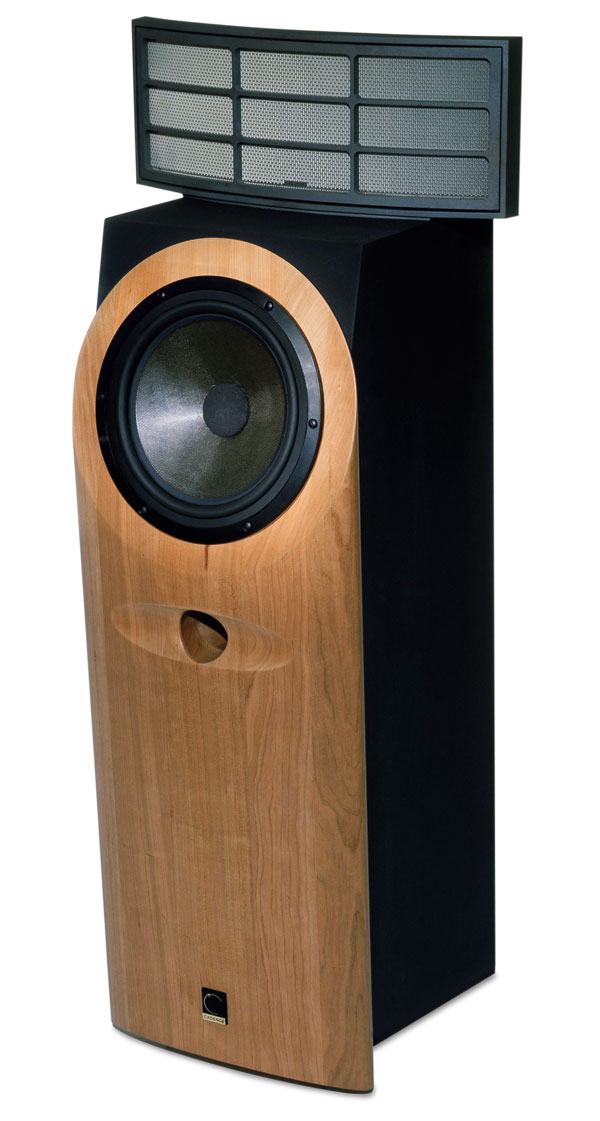Cadence Arca

 The Indian company has reworked its hybrid electrostatic speaker ready for production as the Arca. It's an ambitious project, says Martin Colloms
The Indian company has reworked its hybrid electrostatic speaker ready for production as the Arca. It's an ambitious project, says Martin Colloms
When they weren't playing, I found the appearance of these loudspeakers to be disconcerting because their normally exposed electrostatic elements are shrouded in a black cloth hood to keep out the dust. But when the cloth is removed, and the elements are exposed for use, their silvery perforated stator elements are presented in striking full view.
Belle Curve
In a curved format, which is reminiscent of the famous B&W DM70 hybrid electrostatic of the early 1970s, the electrostatic section of the Cadence Arca is an open dipole structure mounted on a substantial box enclosure that contains a powerful woofer.
Cadence is backed by a major industrial group and is located in Pune, India, and its designer has brought a modern idiom to the Arca, with the dense 50mm to 90mm-thick front baffle in satin-finished cherry solid wood, positioned in relief on the main carcass. The latter is a rectangular MDF box, finished in a dark grey texture paint, in contrast to the silver and light silver-grey metal housing that sits on top and carries the electrostatic element.

Mains power (very little is needed) for the electrostatic element is supplied from a power pack built into the lower enclosure, via a detachable IEC lead. Signal input to the speakers is through five-way binding posts, a twin set fitted to the production speakers to make them bi-wirable. Cadence supplies loudspeaker stands measuring 117mm tall, or a little more once the floor-coupling spikes are fitted.
Technology
This is a two-way design, with the crossover at an aurally-sensitive 1kHz. Low frequencies are handled by a cast-frame 250mm chassis unit with a 21.5cm effective cone diameter. This linear, long-throw driver has a highly rigid, straightsided cone made from a Kevlar composite with a lightweight Nomex honeycomb core. Dual ferrite magnets are fitted while the voice coil is a long-throw design, edge wound. Meanwhile, the Arca's bass is reflex loaded by a ductless port measuring 60mm in diameter, tuned to a low 30Hz. The 80mm port depth is solely determined by the exceptional baffle thickness at this point. Internal volume of the bass enclosure is some 65 litres, promising good bass extension.

Set back on the upper deck, the curved treble electrostatic element is 49cm wide by 19cm high, the curve arranged to widen the radiation angle in the lateral plane. Exotic, tropicalised materials are used for high reliability, including silver-plated stators and Teflon diaphragm elements. As editor Steve Harris pointed out, other electrostatic units can fail to work in a humid climate, but Cadence has overcome this issue.
The frame is gravity-cast in light alloy for exceptional rigidity and freedom from resonance, the final shape achieved by a labour- intensive precision milling process. A high-quality step-up transformer is used for this highly linear, push-pull treble transducer. Internally, van den Hul cable is used for the bass unit and silver Teflon wire for the treble. The 91dB sensitivity specified by Cadence is above average, while extended bass to 30Hz and power handling of 200W are indicated.
![]() Character Actor
Character Actor
For this review, the amplification used included Krell FPB-600 and 300, Cary 805C, Musical Fidelity A1000 and XTC PRE-1/POW-1, fed from Krell KPS 20i/l and a Linn LP12/Lingo/Aro/Koetsu Rosewood Signature II (via Conrad Johnson Premier 15). Comparisons were made with Audio Physic Caldera II, Wilson WITT, Wilson System Five and Quad ESL63 speakers.

After using the Arca in both my listening rooms, I concluded that it was better suited to the larger, better-damped area. Bass output from the speaker was full, very well extended and apparently with a classically flat response. I detected little or no sign that it had been tailored for room-matched alignment.
It quickly became apparent that the Arca displayed more character than usually encountered these days, its rich, sweet sound, overall balance and the way it voiced the listening room being reminiscent of an old 1957 Quad ESL with extra bass extension and power. Rock music played through the Arca will sound too saccharine for some tastes, though its delicate upper range helps to control the effect of distortion and roughness in poorer quality material. Conversely, many speakers do not have the clean, deep bass – of virtually subwoofer quality – which this Cadence design can provide.
Shout To The Top
Initially, several programme excerpts passed without undue comment and then that awful moment arrived – a readily appreciated incompatibility of the speaker with sections of familiar recordings. I had a similar experience with the generally admirable and musically-involving Yamaha NS10 nearfield monitors, all being well until a particular upper midrange band is reached, whereupon the little NS10s jumped up and bit my ears off.


















































